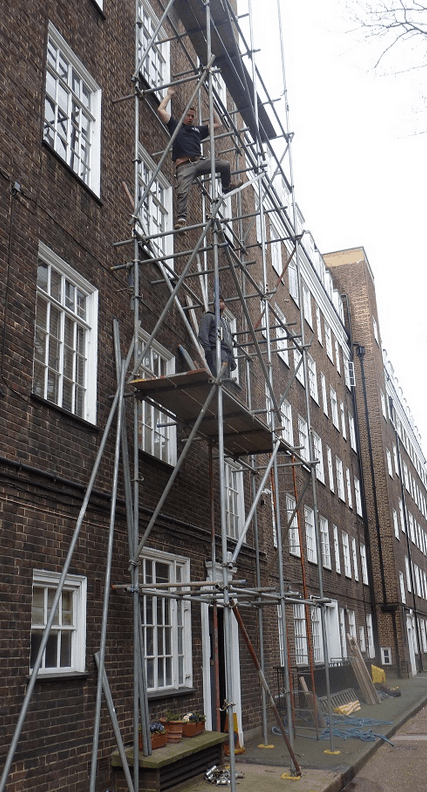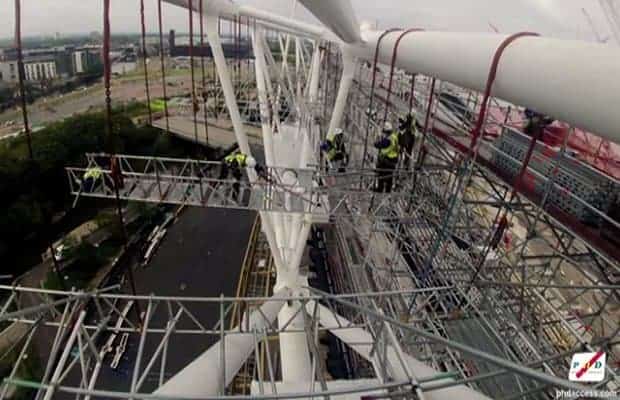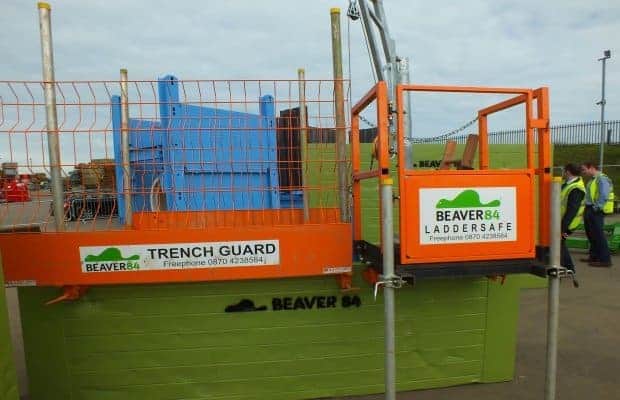Terry Sennett – Funeral Details Announced
The family of the late Terry Sennett who tragically died in Dubai on the 20 December have announced funeral arrangements for the well known industry leader.
Terry was a true leader in the access industry, a hugely respected and highly knowledgeable industry champion, that dedicated his life to the UK and worldwide scaffolding Industry.
The funeral arrangements are as follows:
Tuesday 20 January 2015 – 12.30pm
East Chapel
Southampton Crematorium
Bassett Green Road
Southampton
Hampshire
SO16 3QB
Bright colours are to be worn in celebration of Terry’s life, everybody is welcome !
Terry Sennett 1966 – 2014
Terry Sennett 1966 – 2014
Terry Sennett, a hugely respected scaffolding industry leader has died suddenly aged 48.
Its with tremendous personal sadness I have to inform our readers of the tragic news that Terry Sennett passed away on Saturday 20th December after a very short illness at his home in Dubai.
‘There are leaders and there are those that lead’….Terry was a true leader in the access industry, a hugely respected and highly knowledgeable industry champion, that dedicated his life to the UK and worldwide scaffolding Industry. His infectious passion and inspirational character will be so greatly missed by myself, and everyone else who had the pleasure in working with him.
Terry Sennett 1966– 2014
Embarking into a career in scaffolding Terry started out as a trainee scaffolder in 1987 for Dixion Scaffolding Ltd until 1989 when he ventured offshore with Aberdeen Scaffolding Ltd. Here he was in his own words “taken to school” while working on various platforms in the North Sea gaining valuable scaffolding knowledge from two Glaswegian scaffolders.
After two years working offshore Terry decided to establish his first successful company in Southampton, Finest Scaffolding & Access Ltd in 1991. Twenty two successful years passed and Terry moved on to founding his next scaffolding venture, Modus Access UK Ltd in 2010. Modus Access used only Layher system scaffolding, and he created his own “systems thinking” mindset and management approach. He demonstrated time and time again what was possible with system scaffolding, challenging convention and creating a new standard of compliant and cost effective scaffolding – something which has yet to be matched.
In 2013 Terry decided to give something back to our industry by passing on his extensive scaffolding and technical knowledge by educating others. He worked as the Senior Layher Expert & Training Instructor/Assessor for Safety & Access Ltd in Nottingham & Immingham, UK until moving to the Middle East full time for Simian Skill as GCC Manager in 2014.
Just a few months ago I was fortunate to spend a week with Terry at his home in Dubai, UAE while covering an article on overseas scaffolding training. During my time in Terry’s company I couldn’t help but be inspired by his infectious personality and drive for educating others with his extensive and wide ranging scaffolding and technical knowledge. He had many pioneering and revolutionary training ideas that would make a fundamental change to training provision in the Middle East, which in-turn would inevitably save many scaffolders lives.
 Terry was already implementing some of those pioneering ideas with the co-founding of 48.3 International Design & Technical Services in November 2014.
His close friend and co-founder at 48.3 International, Ben Beaumont said:
“This is desperately sad time for everyone. Terry was a true industry professional; knowledgeable, dedicated, highly skilled and unwavering in the pursuit of his goals. He viewed himself, and all scaffolders as ‘construction professionals’ and was known for saying to his team ‘just because we go to work with a tool belt and high-vis, doesn’t make us any less professional than the man in a suit’. He embodied modern working practices and was a role model for not just scaffolders, but all of us. Everyone will dearly miss him and our thoughts are with his family at this time.”
From the beginning, Terry had always believed in ScaffMag and what the website stood for, he believed in me, and our cause, always on hand night or day for advice and support. For me personally, Terry will always be remembered for his inspirational words of wisdom and his challenging the norm attitude. I will miss him so very dearly….
I send my heartfelt condolences to Terry’s wife, Fiona and the Sennett family and, of course, his many friends and colleagues worldwide.
Terry was already implementing some of those pioneering ideas with the co-founding of 48.3 International Design & Technical Services in November 2014.
His close friend and co-founder at 48.3 International, Ben Beaumont said:
“This is desperately sad time for everyone. Terry was a true industry professional; knowledgeable, dedicated, highly skilled and unwavering in the pursuit of his goals. He viewed himself, and all scaffolders as ‘construction professionals’ and was known for saying to his team ‘just because we go to work with a tool belt and high-vis, doesn’t make us any less professional than the man in a suit’. He embodied modern working practices and was a role model for not just scaffolders, but all of us. Everyone will dearly miss him and our thoughts are with his family at this time.”
From the beginning, Terry had always believed in ScaffMag and what the website stood for, he believed in me, and our cause, always on hand night or day for advice and support. For me personally, Terry will always be remembered for his inspirational words of wisdom and his challenging the norm attitude. I will miss him so very dearly….
I send my heartfelt condolences to Terry’s wife, Fiona and the Sennett family and, of course, his many friends and colleagues worldwide.
The industry has lost a true legend….. RIP Terry Sennett.
SGB officially returns to the industry
SGB launches new website, firmly highlighting the return of a once legendary industry giant.
The launch of a new website has heralded the return of one of the scaffolding industry’s most recognisable names. After an absence of some 3 years, the website – www.sgb.co.uk – marks the return of the SGB name to the commercial scaffolding and access market. Established in 1919, SGB went on to become one of the industry’s best known and respected names within the access services field, before becoming part of Harsco Infrastructure in 2009. Following the subsequent merger of Harsco Infrastructure and Brand Energy & Infrastructure Services, the decision was taken to reintroduce the SGB name – a move which has re-focussed attention on the wealth of scaffolding and access expertise available from the company. “The new SGB website firmly reinforces that message,” says Kevin Fitzpatrick, UK Head of SGB. “It also highlights the tremendous emphasis that we place on safety by including details of the various safety organisations were are members of. These include the Construction Health and Safety Group, the British Standards Institute and the British Safety Council. “Visitors to the site can also find full details of the contracting, hire, sales and training services we offer. That includes information on our wide range of products, including our traditional tube and fitting scaffolding and our CUPLOK®modular system, plus details of our MastclimbersTM and light access solutions.” The wealth of industry expertise which lies behind the SGB name is another key focus of the website. “It explains how we can provide both general and technical guidance on such areas as access project planning and logistics,” adds Kevin. “This ensures that our customers not only benefit from the most effective solution for their project, but that they do so while complying with the latest guidelines, regulations and policies on such critical areas as health and safety.”Management reshuffle drives rapid growth for the TRAD Scaffolding Group
Following the acquisition of the TRAD Group in September 2013 by the International ALTRAD Group which has a 1 Billion Euros Turnover TRAD has experienced rapid growth across all three Companies in the TRAD Group resulting in a dynamic management re-structure becoming necessary.
Des Moore the Managing Director of TRAD Scaffolding for the past fifteen years is taking on the role of Group MD on a full time basis, this will enable Des to fully focus on orchestrating and managing the continued expansion of all three present Companies of the TRAD group being TRAD Hire & Sales Ltd, TRAD Safety Systems Ltd and TRAD Scaffolding Co Ltd over the coming years.
Neil Garner who previously held the position of Divisional Director of TRAD Scaffolding and who has risen through the ranks over the past twenty years has been promoted to Managing Director effective from the 1st of December 2014.
Peter McShane who has also risen through the ranks over the past twenty years with TRAD and previously held the position of Senior Contracts Manager has been promoted to the role of Divisional Director again effective from the 1st December. Peters Division is one of three Contracting Divisions in the TRAD Scaffolding Business the other two led by Chris Smith and Tony Mileham.
Hayden Smith Group Chairman and the founder of the TRAD Group commented:
“We have always believed in promoting from within our ranks and making the most of the talent we have, this allows us to retain continuity of performance and customer service and gives opportunity to people that want to push the boundaries to do even better.
With each TRAD Group Company outperforming their budgets the changes outlined in our restructure at TRAD Scaffolding allows Des to focus all of his four decades of experience in the Industry on managing the entire TRAD Group as opposed to just our scaffolding division, a role he has been actively performing very successfully for the past five years.
Des, Neil and Peter are all prime examples of the tight team that’s given TRAD the respect it now commands and I and the Board of Altrad wish them every success in their enhanced roles”.
PERI proves roaring success at UK’s largest zoo exhibit
Construction work on a £30 million project that will result in the UK’s largest indoor zoo exhibit is currently underway, with PERI Ltd playing a major role in supporting LOR with their in-situ concrete works on site.
Chester Zoo – the subject of a new BBC drama – is currently undergoing a major transformation with the creation of one of the most ambitious zoo developments in Europe. In 2015, the exotic islands project will result in the introduction of a truly unique environment that will house endangered species and introduce visitors to a sub-tropical climate in Cheshire. PERI, the world’s largest provider and manufacturer of formwork and scaffolding systems, has been involved in the project since November 2013. It has provided unique engineering solutions for contractor Laing O’Rourke, tackling the challenges of various complex enclosures, including specially crafted bridges and secure internal walls that will see the zoo’s estate extend by 12%. The new enclosure will cover six different South East Asian island habitats. Supporting Laing O’Rourke in their planning and approach, PERI was able to design unique platform supports to support the internal enclosure walls to the main Indonesian jungle house. Scaling heights ranging from 1.5 to 7.5 metres, as well as overcoming the difficulties of openings within the walls which had a variety of shapes and sizes, PERI combined its CB climbing formwork with the RUNDFLEX circular wall formwork to ensure secure, safe and reliable support that could adapt to the varying curved wall structures. For the straight walls, PERI TRIO was used, providing those on site with a universal formwork system. The system’s minimal components results in faster formwork and can cope with the demands of the contrasting geometry of the structure. Other equipment from the PERI range currently being used on site at Chester Zoo includes: PERI UP scaffolding to construct 70 linear metres of brickwork; the CB climbing systems to support large-sized wall construction; the MULTIPROP shoring system, as a high-strength lightweight prop and cost-effective shoring tower. Ian Higginbottom, Sales Manger at PERI said: “We always relish the challenge of being involved in the most ambitious projects. The Chester Zoo islands exhibit has presented many technical challenges including ensuring that the correct sequencing of PERI equipment was used. We have also been able to demonstrate our design capabilities with our teams in Leeds and Birmingham tailoring the CB platforms with both TRIO and RUNDFLEX formwork. “We have a fantastic relationship with Laing O’Rourke and this project has allowed us to support the construction team by visiting the site and demonstrating to them how to use our equipment efficiently and effectively. This in turn has ensured that on-site safety has been maintained to the highest level, standards of construction have remained high and the various stages of construction have met their deadlines thanks to the support our systems provide and the high quality of the Laing O’Rourke team.” The Island will be the largest indoor zoo exhibit in the UK and will be the home of Sumatran orang-utans, Sulawesi macaques and the sunda gavial crocodile, a new species for the zoo. Expected to bring an extra 150,000 visitors a year, the project is set to be completed in the spring of 2015.VIDEO: Innovative hanging scaffolding helps transform the Olympic Stadium
PHD Modular Access Services Ltd installed an impressive innovative ring of hanging scaffolds using chains on the Olympic Stadium Transformation.
Working on the Olympic Stadium Transformation project run by main contractors Balfour Beatty, PHD Modular Access Services Ltd developed the innovative use of chains to hang the supporting scaffolding beam work to erect “scaffolding pods” using the Layher Allround® Lightweight system . By implementing the use of chains to hang the supporting beam work saved the firm, the need to use over 250,000 scaffold fittings which in-turn created a safer working environment for all operatives working on the Olympic Stadium Project. Over 480 tonnes of Layher was used in the erection of the “Scaffolding Pods” which provided contractors a fabricating shop work environment, allowing the strengthening works vital to the trusses to be carried out regardless of external weather conditions. The pods allowed the transformation of the Olympic Stadium to continue whatever the weather. PHD erected and dismantled the scaffold all within 6 months on time as per to schedule.Scaffolder caught on film working dangerously
An Essex scaffolder and a labourer he employed risked their lives and endangered the public around them with precarious and unsafe work at a Chelsea property.
Christopher Harker, 35, from Epping, trading as C&H Scaffolding, clambered up and down the outside of a four-storey scaffold in Cheyne Walk on 20 March 2014, completely unconcerned by the fact a fall could have proved fatal. He and his assistant also casually leaned through openings up to 10 metres above the ground and nonchalantly passed materials to each other that could have slipped and caused serious harm to anyone walking below.
The unsafe work continued in full view of an inspector from the Health and Safety Executive (HSE), despite Mr Harker knowing he was present and after the inspector had tried to warn him of the danger.
Westminster Magistrates’ Court heard yesterday (19 November) that there was a complete absence of any form of edge protection on the scaffold to prevent or mitigate falls. Equally, neither worker was wearing a safety harness, there were no access ladders to some of the work areas, and there were large gaps between the boards that also posed a significant fall risk.
Mr Harker used a system where he moved boards from the upper and lower levels of the scaffolding depending on where he or the labourer were working, rather than ensuring that both areas were sufficiently boarded to begin with.
He also casually tossed objects and materials, such as scaffolding clips, to his colleague on the level below him. This not only put the assistant at risk as he moved to catch them, but also members of the public exiting a doorway directly under the scaffold, who could have been struck and injured.
The court was told that the police were required to attend the site such was Mr Harker’s hostile attitude towards the HSE inspector. It was only then that he accepted the risks he had created as the legal dutyholder responsible for the work.
He subsequently apologised unreservedly for his behaviour, complied with all aspects of the HSE investigation and vowed to undertake future scaffolding projects in a safe and legal manner.
Christopher Harker, of Coronation Hill, Epping, Essex, was fined a total of £800 and ordered to pay £577 in costs after pleading guilty to two separate breaches of the Work at Height Regulations 2005. The relatively low penalty reflected the defendant’s limited financial means, early guilty plea and full co-operation throughout.
After the hearing, HSE inspector Andrew Verrall-Withers commented:
serious harm to anyone walking below.
The unsafe work continued in full view of an inspector from the Health and Safety Executive (HSE), despite Mr Harker knowing he was present and after the inspector had tried to warn him of the danger.
Westminster Magistrates’ Court heard yesterday (19 November) that there was a complete absence of any form of edge protection on the scaffold to prevent or mitigate falls. Equally, neither worker was wearing a safety harness, there were no access ladders to some of the work areas, and there were large gaps between the boards that also posed a significant fall risk.
Mr Harker used a system where he moved boards from the upper and lower levels of the scaffolding depending on where he or the labourer were working, rather than ensuring that both areas were sufficiently boarded to begin with.
He also casually tossed objects and materials, such as scaffolding clips, to his colleague on the level below him. This not only put the assistant at risk as he moved to catch them, but also members of the public exiting a doorway directly under the scaffold, who could have been struck and injured.
The court was told that the police were required to attend the site such was Mr Harker’s hostile attitude towards the HSE inspector. It was only then that he accepted the risks he had created as the legal dutyholder responsible for the work.
He subsequently apologised unreservedly for his behaviour, complied with all aspects of the HSE investigation and vowed to undertake future scaffolding projects in a safe and legal manner.
Christopher Harker, of Coronation Hill, Epping, Essex, was fined a total of £800 and ordered to pay £577 in costs after pleading guilty to two separate breaches of the Work at Height Regulations 2005. The relatively low penalty reflected the defendant’s limited financial means, early guilty plea and full co-operation throughout.
After the hearing, HSE inspector Andrew Verrall-Withers commented:
“The scaffolding work at Cheyne Walk posed a clear danger to the two workers as well as members of the public exiting the building under the scaffolding. “The failings were abundantly obvious and trained scaffolder Mr Harker knew this, which is probably why he reacted in the manner he did. He was caught red-handed, panicked and tried to make the problem go away as he saw it. “However, HSE inspectors cannot and will not turn a blind eye when safety is compromised in this manner – as the scaffolder now fully accepts. He understands that safety rules and standards are designed to protect life and limb, and that cutting corners in order to get a job done is simply not acceptable.”












